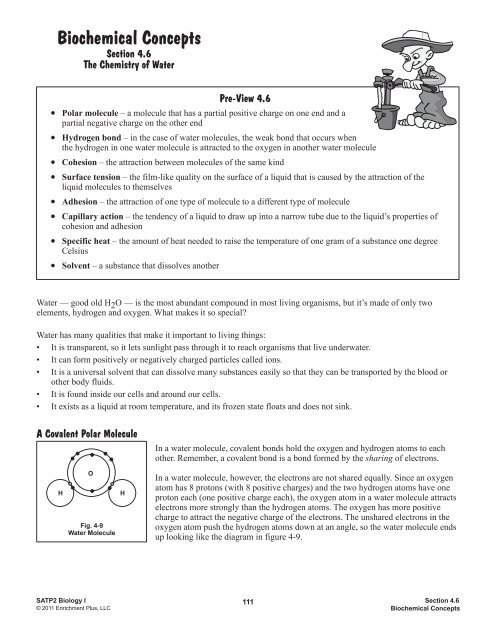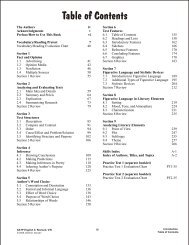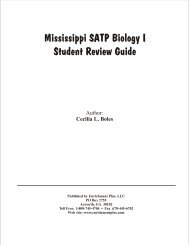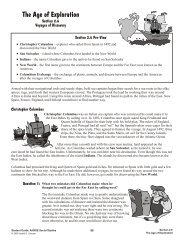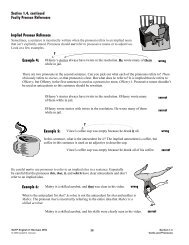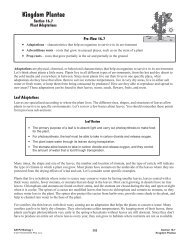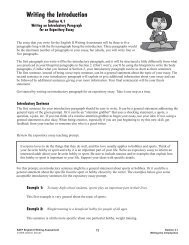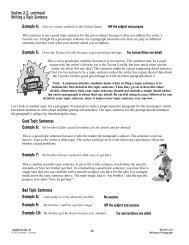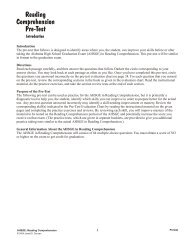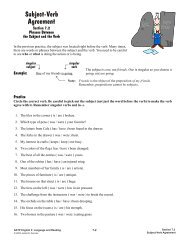Biochemical Concepts - Enrichment Plus
Biochemical Concepts - Enrichment Plus
Biochemical Concepts - Enrichment Plus
- No tags were found...
You also want an ePaper? Increase the reach of your titles
YUMPU automatically turns print PDFs into web optimized ePapers that Google loves.
<strong>Biochemical</strong> <strong>Concepts</strong>Section 4.6The Chemistry of WaterPre-View 4.6 Polar molecule – a molecule that has a partial positive charge on one end and apartial negative charge on the other end Hydrogen bond – in the case of water molecules, the weak bond that occurs whenthe hydrogen in one water molecule is attracted to the oxygen in another water molecule Cohesion – the attraction between molecules of the same kind Surface tension – the film-like quality on the surface of a liquid that is caused by the attraction of theliquid molecules to themselves Adhesion – the attraction of one type of molecule to a different type of molecule Capillary action – the tendency of a liquid to draw up into a narrow tube due to the liquid’s properties ofcohesion and adhesion Specific heat – the amount of heat needed to raise the temperature of one gram of a substance one degreeCelsius Solvent – a substance that dissolves anotherWater — good old H O — is the most abundant compound in most living organisms, but it’s made of only two2elements, hydrogen and oxygen. What makes it so special?Water has many qualities that make it important to living things:• It is transparent, so it lets sunlight pass through it to reach organisms that live underwater.• It can form positively or negatively charged particles called ions.• It is a universal solvent that can dissolve many substances easily so that they can be transported by the blood orother body fluids.• It is found inside our cells and around our cells.• It exists as a liquid at room temperature, and its frozen state floats and does not sink.A Covalent Polar MoleculeIn a water molecule, covalent bonds hold the oxygen and hydrogen atoms to eachother. Remember, a covalent bond is a bond formed by the sharing of electrons.HOFig. 4-9Water MoleculeHIn a water molecule, however, the electrons are not shared equally. Since an oxygenatom has 8 protons (with 8 positive charges) and the two hydrogen atoms have oneproton each (one positive charge each), the oxygen atom in a water molecule attractselectrons more strongly than the hydrogen atoms. The oxygen has more positivecharge to attract the negative charge of the electrons. The unshared electrons in theoxygen atom push the hydrogen atoms down at an angle, so the water molecule endsup looking like the diagram in figure 4-9.SATP2 Biology I© 2011 <strong>Enrichment</strong> <strong>Plus</strong>, LLC111Section 4.6<strong>Biochemical</strong> <strong>Concepts</strong>
Section 5.6, continuedEnzymesBoth temperature and pH will change the shape of an enzyme. Since the shape of the enzyme affects how well itworks on a substrate, enzymes work best at an optimum temperature and pH. Look at the graphs below that showhow temperature and pH generally affect reaction rate.as temperatureincreases, reactionrate increasesoptimumtemperatureas temperatureincreases, reactionrate decreasesas pH increases,reactionrate increasesoptimumpHas pHincreases, reactionrate decreasesreaction ratereaction ratetemperaturepHAlthough the shapes of the curves are a little different, they both show the same trend. They simply show that astemperature or pH increases, reaction rate increases until it gets to an optimum temperature or pH. Then the reactionrate decreases when temperature or pH gets any higher. What point on the graphs represents the optimum temperatureand optimum pH? The optimum is represented by the highest peak on the curve. Generally, enzymes work well in anarrower pH range than temperature range, so the “hill” of the curve is narrower and steeper on the pH graph.Types of EnzymesHumans produce two types of enzymes: metabolic enzymes and digestive enzymes. Humans also obtain and use athird kind of enzyme, food enzymes, from eating raw foods. Remember, enzymes are needed to speed up the rate ofreaction. Reactions that could take days to complete can be completed in minutes or hours when enzymes are used.Metabolic enzymes enable cells to perform cellular reactions. These reactions allow cells to make energy, repairtissues, and eliminate or neutralize wastes and toxic substances.Digestive enzymes are ones that may bemore familiar to you. The name of adigestive enzyme usually ends in -ase, andthe first part of the name often indicateswhat it helps to digest (or break down intosmaller components). Look at the chart onthe right for common digestive enzymesand the substances they digest. Forexample, lactase is an enzyme that breaksdown lactose, the sugar found in milk, intothe monosaccharides of galactose andEnzyme Breaks down —amylaselactasesucraseproteaselipaseCommon Digestive Enzymescarbohydrateslactose (milk sugar)sucrose (table sugar)proteinsfatsInto products of —Disaccharides, monosaccharidesgalactose and glucoseglucose and fructosepolypeptides, amino acidsglycerol and fatty acidsglucose. These are only a few of many. As you can see in the chart, digestive enzymes help to digest the differenttypes of macronutrients. They allow the body to break down food in hours instead of days.Food enzymes also help to break down the foods we eat. Since food enzymes are destroyed at high temperatures, theyare only found in uncooked (raw) foods or from supplements. Consuming food enzymes from raw foods helps thebody to digest the foods without causing as much strain on the body to produce additional digestive enzymes.SATP2 Biology I© 2011 <strong>Enrichment</strong> <strong>Plus</strong>, LLC138Section 5.6The Components of Life
Section 6.3, continuedPlant and Animal CellsFigure 6-5 below shows a labeled diagram of a typical plant and animal cell.Typical Plant CellTypical Animal Cellcell wallcell membranemitochondriacentriolesvacuolechloroplastsnucleusribosomesGolgiapparatusendoplasmicreticulumlysosomeFig. 6-5Both plant and animal cells can reproduce, but the way that they divide into new cells is different. Both have somecell processes such as cellular respiration that are similar. In cellular respiration, cells use oxygen to help break downglucose to release energy and carbon dioxide. You’ll see more about this process in Section 8.Special Animal OrganellesAnimal cells contain centrioles and lysosomes, neither of which are found in plant cells. Remember, centrioles play animportant role in cell division, and lysosomes store enzymes that keep the cell free from debris.Special Plant OrganellesFrom the chart on the previous page and the diagrams above, can you summarize a few things that are differentbetween plant cells and animal cells? Hopefully, you see that the presence of a cell wall, the size of vacuoles, and thepresence of chloroplasts make plant cells different. Let’s take a closer look at each of these.The Cell WallPlant cells have cell walls, but animal cells do not. The cell wall in a plant cell is made of cellulose, a material uniqueto plant cells. Similar to starch, cellulose is a type of carbohydrate. (Cellulose is also known as “fiber,” an importantpart of a human diet.) The cell wall gives support and extra protection to the plant cell.VacuolesMany plant cells have one large vacuole that is filled with water. The vacuole may take up 50% or more of the spaceinside the cell. Vacuoles are used to store water, salts, sugars, wastes, etc. In plants, they can help provide support forthe cell. Most animal cells do not contain vacuoles, and when found in cells other than plant cells, the vacuoles aresmall. Single-celled organisms such as paramecium contain contractile vacuoles that help control fluid balance.ChloroplastsOnly plant cells (and some types of algae) have chloroplasts, so they can go through a special process calledphotosynthesis. In photosynthesis plant cells use light energy, carbon dioxide, and water to produce oxygen andglucose. Remember that glucose is a monosaccharide carbohydrate, or in other words, a simple sugar. Also rememberthat glucose and other carbohydrates store energy. (See Section 5.2 if you need more review on carbohydrates.)Glucose molecules “link” together to form starch molecules, which are stored in plant cells for future use.SATP2 Biology I© 2011 <strong>Enrichment</strong> <strong>Plus</strong>, LLC153Section 6.3Cell Structure and Function
Cellular EnergySection 8.3PhotosynthesisPre-View 8.3 Heterotrophs (also called consumers) – organisms, such as animals, that obtain energy by consumingplants and other animals Autotrophs (also called producers) – organisms, such as plants, that usually use energy directly from thesun to produce glucose and other carbohydrates Carbon fixation – the process of converting the inorganic carbon found in carbon dioxide to organiccarbon in glucose Photosynthesis – process used by autotrophs that uses the sun’s energy to convert water and carbondioxide to glucose (simple sugar) and oxygen Chlorophyll – the green pigment found in the chloroplasts of plant cells that absorbs energy from the sunand uses that energy in the first stage of photosynthesis Calvin cycle – the stage of photosynthesis that does not require lightYou know that all living things need energy, but where does that energy come from? In Sections 8.1 and 8.2, wediscussed how energy comes from converting glucose (or simple sugar) into ATP, but where does the glucose comefrom? The sun is actually the main source of energy for living organisms although many organisms can’t use thatenergy in its original form. All living organisms live by releasing energy found in chemical compounds such asglucose, but some can also use energy directly from the sun to make glucose.Living organisms can be divided into two main groups: autotrophs and heterotrophs. Heterotrophs are organisms,such as animals, that get energy from the sun indirectly by consuming foods that have energy stored in them.Heterotrophs are also called consumers since they must consume food for energy. Autotrophs are organisms, such asplants, that can directly use the sun’s energy to produce energy-containing chemical compounds such as glucose andother carbohydrates. Autotrophs are also called producers since they can produce their own food.Through the process of photosynthesis, most autotrophs use the energy in sunlight to change water and carbondioxide (CO ) into glucose and oxygen. The net equation for photosynthesis is shown in figure 8-10 below:26CO 2 + 6H2Olight energy C H O + 6carbondioxidewaterPhotosynthesisenzymes and chlorophyllFig. 8-106 12 6 O 2glucose(simple sugar) oxygenDo you remember the difference between organic and inorganic compounds that you saw in Section 4.1? You mayremember that carbon dioxide is an inorganic compound even though it contains carbon. Glucose, on the other hand,is an organic compound. So photosynthesis converts carbon from an inorganic compound into an organic one. Thisconversion is called carbon fixation. (Hint: Carbon dioxide cannot be used as food for us as humans. Once plantsconvert it into glucose, it is “fixed” into food that we can eat. The glucose made by photosynthesis helps to make upthe potatoes, apples, lettuce, wheat, etc. that we eat.)SATP2 Biology I© 2011 <strong>Enrichment</strong> <strong>Plus</strong>, LLC184 Section 8.3Cellular Energy
Cellular ReproductionSection 9.2Sexual Reproduction and MeiosisPre-View 9.2 Somatic cells – all cells except sex cells; for example: blood cells, liver cells, skin cells Sex cells (or gametes) – the cells other than somatic cells that are formed through a process called meiosis Meiosis – the process that forms the sex cells called gametes (ova and sperm cells) Haploid cells – sex cells produced through the process of meiosis that contain half the number ofchromosomes for that organism; have an n number of chromosomes Diploid cells – somatic cells produced through the process of mitosis that contain the full number ofchromosomes for that organism; have a 2n number of chromosomes Homologous chromosomes (or homologues) – the two chromosomes that make up each pair of humansomatic cells (23 pairs for a total of 46 chromosomes in humans) Sex chromosomes – the pair of chromosomes that determines gender (male or female) Autosomes – the pairs of chromosomes that do not include the one pair of sex chromosomes and that donot determine gender Tetrad – homologous chromosomes paired together side by side during meiosis Crossing over – the exchange of DNA between paired homologous chromosomes during meiosisGametes (Sex Cells)Organisms that reproduce sexually have two types of cells. As we reviewed in Section 9.1, the cells that make up thebody of the organism are called somatic cells, and they reproduce through the process of mitosis. The other cells arecalled sex cells or gametes, and they are formed using a process called meiosis.Meiosis occurs only in reproductive cells to form egg cells and sperm cells. Unlike mitosis, meiosis does not producetwo new genetically identical cells. Instead, the cells produced by meiosis are called haploid cells. Haploid cells haveonly half the usual number of chromosomes that other cells have. These cells are said to have an n number ofchromosomes. Somatic cells are said to be diploid and contain the full number of chromosomes for any givenorganism. Somatic cells are said to have a 2n number of chromosomes. For example, human somatic cells have23 pairs of chromosomes for a total of 46 chromosomes. The diploid number of chromosomes for humans is 46.Human egg and sperm cells are haploid, which means they have only 23 chromosomes, not 23 pairs. When one eggwith 23 chromosomes is fertilized by one sperm with 23 chromosomes, the offspring will have 46 chromosomes(23 pairs), the correct number for humans. If gametes were produced by mitosis, then each gamete would have46 chromosomes, and the first set of offspring would have 92 chromosomes — twice as many as normal!Somatic cells in an organism contain pairs of chromosomes that carry similar genetic information. The twochromosomes that make up each pair are called homologous chromosomes or homologues. One chromosome fromeach pair came from the mother’s egg cell, and the other chromosome for each pair came from the father’s sperm cell.Each pair of homologues contains similar information. For example, one pair of homologues will contain genes thatdetermine eye color. One of the chromosomes may have information for blue eyes from the mother, and the other mayhave information for brown eyes from the father.SATP2 Biology I© 2011 <strong>Enrichment</strong> <strong>Plus</strong>, LLC197 Section 9.2Cellular Reproduction


